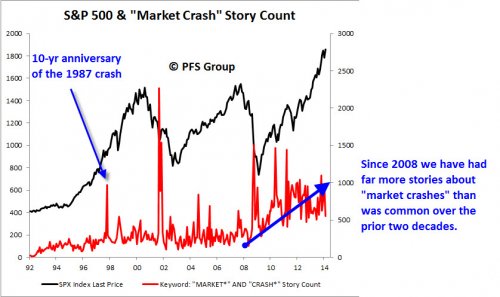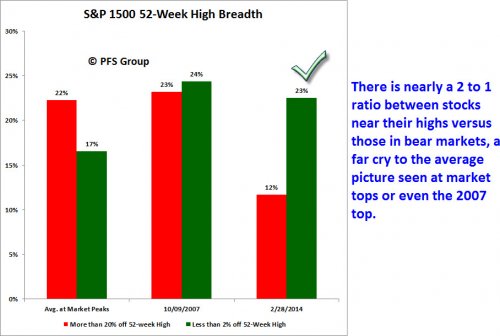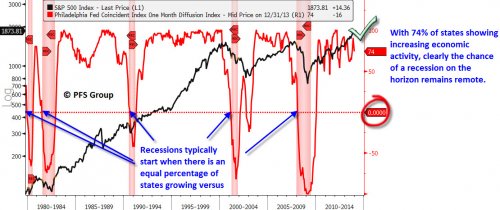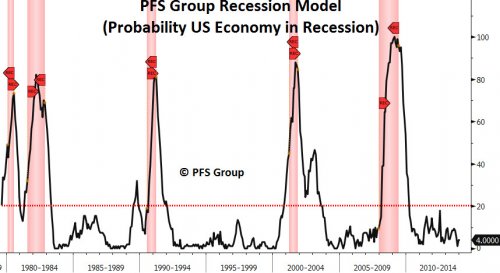It seems we can’t go a week without someone predicting the end of the world and stirring up everyone’s fears of a market meltdown. These apocalyptic warnings are becoming routine and the sad thing is that it does cause the squeamish individual investor to run for the hills and liquidate their investment portfolio. Just look at the market calls for a crash over the last few years:
- Dow Could Crash to 3,000 in 2013 — Harry Dent (09/12/2011)
- Dow Dropping to 5000 Starting This Year: Charles Nenner (03/04/2013)
- S&P 500 May Fall More Than 40% By Fall: Chris Martenson (04/10/2013)
- Look Out! A 1987-Style Crash is Coming — Marc Faber (08/08/2013)
- The Case for a Crash: And for Staying in Cash Until 2015 — Charles Hugh Smith (12/10/2013)
- The Next Two to Three Days Are ‘Extremely Critical’ For The Stock Market — It May Crash 40% - Tom DeMark (02/5/2014)
- Get Ready for the Dow at 6,000 by 2016 — Harry Dent (03/03/2014)
Whenever a client refers me to an article of someone calling for a crash I like to respond with a question: How many crashes can you list over the last century? I’m not talking about a 20%+ bear market, but a market crash as defined by Investopedia:
A rapid and often unanticipated drop in stock prices. A stock market crash can be the result of major catastrophic events, economic crisis or the collapse of a long-term speculative bubble. Well-known U.S. stock market crashes include the market crash of 1929 and Black Monday (1987).
Think about that, we have had two real market crashes occur in the last 100 years, which works out to about one every 50 years. If they are so infrequent, then why do we hear so much about them? I'll give two reasons: One, people often crave attention and can easily gain it by making bold forecasts (whether they turn out incorrect or not) and, two, people assign a higher probability to market crashes now than they have in the past.
For example, shown below is the S&P 500 along with a Bloomberg story count for articles that have the words “market crash” in them. Since the early 1990s, we saw a spike on the 10-year anniversary of the 1987 market crash, then another around the September 11th 2001 terrorist attacks, and then again on the big October swoon of 2008. I want to draw your attention to the first two spikes in 1997 and 2001 and point out that, once they calmed down, fears over a “market crash” returned to normal levels. However, after 2008, there has been a continual and ongoing spike in calls for a market crash unlike anything we've seen over the prior two decades.

This brings up an important point—a theme really—that I try to stress again and again: To be successful as investors we can’t fixate on the recent past, nor complain about what should be happening, but rather focus on what is taking place and why.
I typically write one to two articles a year on the subject of being flexible and want to include an excerpt from an article I wrote back in 2009:
Where Is the Humility? (12/09/2009)
All investors will be wrong at some point and the trick is to admit your error in judgment early rather than being a broken clock that is eventually right well down the road. Being wrong is human; being stubborn in the face of changing facts is foolishness. Another pearl of wisdom summing up this thought comes from famous investor Peter Bernstein who said the following after a long and successful investment career (emphasis added):
After 28 years at this post and 22 years before this in money management, I can sum up whatever wisdom I have accumulated this way: The trick is not to be the hottest stock-picker, the winning forecaster, or the developer of the neatest model; such victories are transient. The trick is to survive. Performing that trick requires a strong stomach for being wrong, because we are all going to be wrong more often than we expect. The future is not ours to know. But it helps to know that being wrong is inevitable and normal, not some terrible tragedy, not some awful failing in reasoning, not even bad luck in most instances. Being wrong comes with the franchise of an activity whose outcome depends on an unknown. Look around at the long-term survivors at this business and think of the much larger number of colorful characters who were once in the headlines, but who have since disappeared from the scene.
Remain Bullish Until the Market and Economy Undergo an "Identity Crisis"
In light of the above, it is important not to extropolate out too far in the future, but to focus on how fundamental drivers of the stock market and economy are changing on a daily, weekly, and monthly basis. For example, if the majority of stocks are in strong uptrends across most time-frames (as measured by short to long moving averages), I have to conclude the bull market in stocks is alive and well. Similarly, if the bulk of U.S. states are showing increasing economic growth, it’s logical to assume the economic recovery remains in place. What investors must understand is that market tops and economic peaks are a process and do not occur overnight. Rather, there is a period of time in which fewer and fewer stocks participate in the bull market and fewer and fewer states showing increasing economic growth.
There comes a point where the number of stocks rallying versus the number of stocks in their own private bear markets is roughly equal. The same is true for the economy where eventually there are an equal number of states participating in a recovery versus those that are not. This is the identity crisis point in which you have the potential transition from a bull to a bear market and from an economic recovery to a recession. However, until you reach the identity crisis point you have to adhere to the Wall Street maxims, “The trend is your friend” or “Don’t fight the tape.”
Consequently, much of my research is focused on looking for clues as to how close we are to that identity crisis point. On Fridays, I throw the stock market under the microscope with my “Weekly Bill of Health” report to gauge the level of participation in the bull market; as long as the bulls have the upper hand I remain bullish. An example of this is by looking at the percentage of stocks within the S&P 1500 that are within 2% of their 52-week highs versus those that are down more than 20% from their 52-week highs. This builds on the study done by Lowry Research Corp. in which they found that at major bull market tops, on average, only 16.54% of stocks were within 2% of their 52-week highs while 22.26% of stocks were 20% or more below their 52-week highs. This highlights the fact that market tops have an identity crisis when they peak as there are roughly an equal percentage of stocks near new highs as those already in bear markets.
Below is data from Lowry’s showing the average breadth of stocks at market tops compared to the 2007 top and the recent breakout to new highs on February 28th in the S&P 1500 (the S&P 1500 encompasses nearly 92% of the entire US market cap). As we can clearly see from the columns on the far right, there is absolutely no identity crisis present in the markets as bullish stocks clearly outnumber bearish stocks, with overall breadth quite healthy.

Given the bulls clearly have control of the stock market it makes sense that the economic bulls hold control of the economy. This can be seen when looking at the Philadelphia Fed’s Coincident Diffusion Index for all 50 states. Referring back to the identity crisis moment I mentioned, typically we see the onset of a recession when the Philly Fed’s Diffusion Index is zero, meaning there is an equal number of states expanding as those contracting. These periods are highlighted by the blue arrows below and what is most important is the fact that the Philly Fed Diffusion Index rested at 74 as of the end of December, well above the zero line associated with recessions.

Given the strong economic breadth seen in the Philly Fed data, it comes as no surprise that our own recession probability model shows only a 4% chance the U.S. is in or near a recession.
We truly live in interesting times and we need to open our minds to make sense of how to navigate as an investor while also avoiding falling into the "perma-bear" or "perma-bull" camp. If we are to succeed and thrive in this climate we have to be able to adapt and remain flexible, which was a key concept in a great book written by Louis-Vincent Gave, “Too Different For Comfort.” Louis was recently interviewed by Jim Puplava on the Financial Sense Newshour and you can listen in to the four key themes Louis believes will drive the markets over the coming years by clicking here.
I’d like to end this article with the concluding remarks by Mr. Gave in his book, which are as priceless as they are timely:
This leads me to conclude with the words of my departed friend Clay Allen: “Remember Louis, money managers are not paid to forecast. Money managers are paid to adapt.” Unfortunately, adapting to this ever-more rapidly changing world is not always easy — but there is no other recipe for making money in today’s world.
